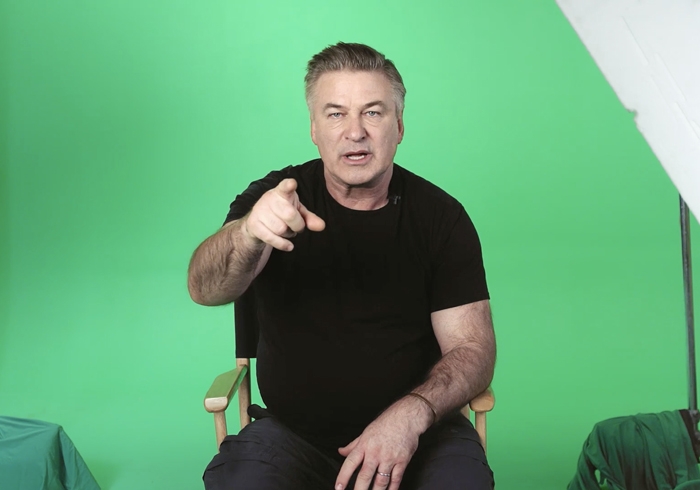KOW, Berlin, 29 April – 30 July
Candice Breitz’s film installations come with the ponderous air of a media-studies department already about them. They roughly divide into appropriated clips of celebrities and of ordinary people imitating them. Think of those odd glitches in Jean-Luc Godard’s early films, when characters would jadedly fix their gaze on the camera, as if to say, I know I’m in a film, and what of it? In Breitz’s work, Godard’s exception is the stifling rule: everything is framed as ‘mediated’, in heavily inverted commas. Her recent installation Love Story (2016) is a single-screen projection that alternates between clips of two A-list Hollywood stars – Alec Baldwin and Julianne Moore – acting for Breitz, not excerpted from their movies. This is obviously an artist with clout.
Like exotic specimens pinned to a baize board, within the minimalistic frame of the concrete-walled gallery, they are dressed in black and seated in director’s chairs against a green screen used by filmmakers to enable alternative backdrops to be inserted during postproduction. When the camera pans out, reflector screens on stands are visible, as if casually placed. Like the green foil, they are signposts signalling ‘film production’. The projection is screened at one end of a severe bunkerlike room, curtained off from the rest of the gallery – another sign for the huis clos of cinematic experience: the darkening of the theatre, the curtain parting onto fantasy. So far, so conforming to the conventional lineaments of a filmmaker’s critique of her medium.
The refugees are effectively silenced on monitors, while the famous voices, speaking their words, boom through the architecture
But the scripts are transcribed from interviews with six asylum seekers. The casting of the stars as ‘talking heads’, playing the interviewees, recalls Breitz’s earlier films of fans performing favourite tracks by Michael Jackson or John Lennon, but with the roles of celebrity and anonymous conduit inverted. Downstairs, in an even more isolated – ‘subterranean’, the press release resonantly puts it – room, the original interviewees speak on plasma screens, headphones attached. Among them are a homosexual professor from Caracas, an Indian transsexual, a Syrian teenager and a musclebound Angolan, each recounting the persecution that prompted their uprooting, and a perilous journey to the havens of Berlin or New York. Three women and three men are acted by Moore and Baldwin respectively.
The difference in presentation is telling. The refugees are effectively silenced on monitors, while the famous voices, speaking their words, boom through the architecture. Relegating the original to the basement’s menagerie of screens displaces the refugees’ stories behind the facade of cinematic artifice, while their presence undermines the attempt to impersonate them, making the actors’ performances a remote second-best to the more direct trace of experience on offer downstairs. The spectacle of the main projection reverses this priority in the interests of symbolically assenting to our demand for the celebrity image as a prerequisite to gaining our attention. The scripts touchingly acknowledge this bias when the refugees thank the actors for extending the reach of their accounts.
what might be being rehearsed is the loss of identity, even subjectivity
The theme is topical, and Breitz is not the first to adopt it. I recently saw an installation by Bouchra Khalili, also consisting of interviews, on simultaneous screens, with refugees describing the ordeal of getting from an African or Middle Eastern A to a European B. The accounts were onerous. Love Story is relatively light viewing; it is in the virtuosity of its editing that it most eloquently evades the self-indulgence of taking its painful documentary material as a pretext for medium self-reflexivity. The staccato rhythms of the main projection – rapidly switching between the actors registering the halting, apologetic delivery of the refugees’ stuttering English – resemble a rehearsal, and what might be being rehearsed is the loss of identity, even subjectivity; that of the actors who submit themselves to impersonating the refugees, and of the refugees who submit their words to the actors. Both are metaphors for the loss, through forced flight, of the culture that confirms an individual’s identity, as for our vicarious investment in the surrogate presences of the celebrities we idolise. Lines from different transcripts are spliced into a stream that creates narrative by subordinating individual testimony to a relay between Baldwin and Moore. Paradoxically, these two epitomes of the process by which a star’s recognisable presence invests a spectrum of identities, in one film after another, have become vehicles for the dissolution of the trace of personalities they are strenuously labouring to capture. The last line of the main projection is “Here I am”, which of course is exactly where he or she is not.
From the September 2017 issue of ArtReview
